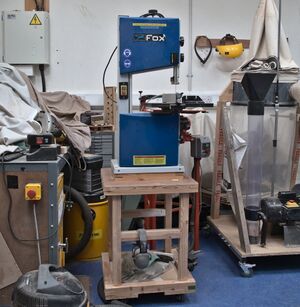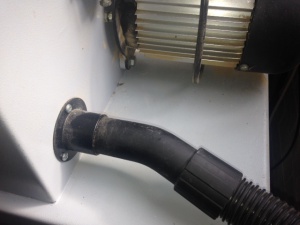Band Saw: Difference between revisions
Jump to navigation
Jump to search
MWainwright (talk | contribs) added info re belt drive and added some instructions to the basics |
|||
| Line 11: | Line 11: | ||
* Max cutting capacity throat 254mm | * Max cutting capacity throat 254mm | ||
* Max cutting capacity-height 150mm | * Max cutting capacity-height 150mm | ||
* The table insert needs to be in the correct orientation silver side up, the wrong side is coloured in red | |||
* When plugged in and socket turned on the attached dust extractor will automatically start running. you then use the start/stop to control the bandsaw. | |||
* the blade should be pre tensioned and aligned on wheels but you should check this before each use. | |||
* the ceramic guides should be position about 2mm from the blade. the side ones should also sit behind the gullet of the blade. currently one of the lower guides is broken. | |||
[[File:bandsaw-extraction.jpg|300px|thumb|right|Attach the shop vac to the dust extraction port]] | |||
== Safety == | == Safety == | ||
| Line 24: | Line 27: | ||
The machine will take 1820mm blades 3-12.8mm deep. | The machine will take 1820mm blades 3-12.8mm deep. | ||
The drive belt is a PJ330 BELT 4 RIB J SECTION POLY V 330MM | |||
== Risk assessment for use of Band Saw. == | == Risk assessment for use of Band Saw. == | ||
Latest revision as of 22:10, 25 April 2025
![]() Warning! This page is out of date. This page references the small bandsaw (we have a bigger one). It also lacks an equipment box
Warning! This page is out of date. This page references the small bandsaw (we have a bigger one). It also lacks an equipment box

We have a Fox F28-186 band saw (like this one here)
The Basics
- Motor 370w
- Table dimensions 340x340mm
- Table tilt angle 0-45degrees
- Max cutting capacity throat 254mm
- Max cutting capacity-height 150mm
- The table insert needs to be in the correct orientation silver side up, the wrong side is coloured in red
- When plugged in and socket turned on the attached dust extractor will automatically start running. you then use the start/stop to control the bandsaw.
- the blade should be pre tensioned and aligned on wheels but you should check this before each use.
- the ceramic guides should be position about 2mm from the blade. the side ones should also sit behind the gullet of the blade. currently one of the lower guides is broken.

Safety
- This is a finger removing machine - treat it with serious respect.
- Ensure guards are in place.
- Use a push stick if you need to push the work anywhere near the blade.
Spares
The machine will take 1820mm blades 3-12.8mm deep.
The drive belt is a PJ330 BELT 4 RIB J SECTION POLY V 330MM
Risk assessment for use of Band Saw.
Hazards.
- 1) Clothes becoming entangled.
- 2) Wood dust inhalation.
- 3) Removing workpiece with machine running breaks blade and causes projectile injury
- 4) Loss of fingers.
- 5) Loss of limb / hand.
- 6) Damage to eyes from particles
Persons at risk.
- Operator.
- Persons nearby.
Initial assessment of risk.
| Hazard identified | Severity | Probability | Risk Factor |
| Clothes becoming entangled | 3 | 2 | 6 |
| Wood dust inhalation | 2 | 3 | 6 |
| Removing workpiece with machine running breaks blade and causes projectile injury | 2 | 4 | 8 |
| Loss of fingers | 3 | 3 | 9 |
| Loss of limb / hand | 4 | 2 | 8 |
| Damage to eyes from particles | 3 | 3 | 9 |
Control measures.
- Users will be required to demonstrate competence to use the machine safely.
- Safety glasses will be worn.
- Keep hands away from the saw
- Do not remove workpiece from curved cuts with machine running
- Ear protection will be worn.
- Dust mask will be worn.
- Tie back long hair and secure loose clothing.
Final assessment of risk
| Hazard identified | Severity | Probability | Risk Factor |
| Clothes becoming entangled | 3 | 1 | 3 |
| Wood dust inhalation | 2 | 3 | 6 |
| Removing workpiece with machine running breaks blade and causes projectile injury | 2 | 2 | 4 |
| Loss of fingers | 3 | 1 | 3 |
| Loss of limb / hand | 4 | 1 | 4 |
| Damage to eyes from particles | 3 | 1 | 3 |
Points system
| Hazard severity | Points Rating | Definition |
| Nil | 1 | Very minor injury, bruise, graze, no risk of disease. |
| Slight | 2 | Minor injury, which would allow the individual to continue work after first aid treatment on site or at a local surgery. The duration of the stoppage or treatment is such that the normal flow of work is not seriously interrupted. |
| Moderate | 3 | Temporary disability causing injury or disease capable of keeping an individual off work for three days or more and reportable under RIDDOR |
| High | 4 | Causing death, serious injury or permanent disability to an individual. |
| Very high | 5 | Causing multiple deaths and widespread destruction eg. fire, building collapse. |
| Hazard likelihood | Points Rating | Definition |
| Remote possibility | 1 | There is really no risk present. Only under freak conditions could there be any possibility of an accident or illness. All reasonable precautions have been taken - This should be the normal state of the workplace. |
| Unlikely | 2 | This incident or illness might occur but the probability is low and the risk minimal. |
| Possible | 3 | The accident may occur if additional factors precipitate it, but it is unlikely to happen without them. |
| Highly likely | 4 | Will happen more often than not. Additional factors could precipitate an incident but it is still likely to happen without this additional factor. |
| Inevitable | 5 | If the work continues as it is, there is almost 100% certainty that an accident will happen, for example:
A broken stair or broken rung on a ladder Bare, exposed electrical conductors Unstable stacks of heavy boxes |
| Risk Rating Score | Definition | Action |
| 1 to 4 | Low | No action required |
| 5 to 9 | Moderate | Reduce risks if reasonably practicable |
| 10 to 15 | High Risk | Priority action to be undertaken |
| 16 to 25 | Unacceptable | Action must be taken IMMEDIATELY |